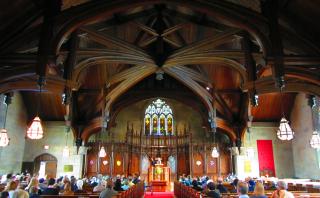Advertisement
Located in a vibrant downtown neighborhood, the Unitarian Universalist Church of Buffalo, New York, was designed in 1904 by Unitarian brothers Edward Austin Kent and William Winthrop Kent and completed in 1906. Edward was a well-known architect who had studied at the famous École des Beaux-Arts in Paris. Just six years after the Buffalo church was completed, he died aboard the Titanic en route to his retirement in the United States. Architectural historian Austin M. Fox described the church as “Kent’s chef-d’oeuvre” saying that it “forms a perfect small entity.”
Bill Parke, the church’s historian and a fourth-generation member, said the building sits on land that was sold to the church at a bargain price by John J. Albright, an industrialist and philanthropist whose estate (demolished in 1935) was right next door. Albright wasn’t connected to the church, but he set two conditions on the sale of the land that influenced the church’s appearance: He had to approve the architecture, and the building had to be set back 70 feet from the sidewalk. “Albright knew how important it was to have properties near his estate exist in harmony with his own,” said Parke.
The exterior of the cruciform-plan church evokes fifteenth-century English Gothic architecture, utilizing a foursquare tower, a slate roof, and Indiana limestone. The interior is in the Arts and Crafts style with Art Nouveau details in the stained glass windows and wrought iron strap door hinges. Among the church’s most notable features are its carved entrance screen, pulpit, and sedilia in the chancel, and the solid oak hammer beam ceiling, which Parke says “provides congregants with the experience of being in a truly majestic sanctuary that is also built to a human scale, so that worship is beautiful and enjoyable but not overwhelmed by too imposing a gathering space.”
In 2001, the church added a new garden entrance—part of the Kents’ original vision for a sunroom, which was discovered in the 1990s while looking at the 1904 drawings.
On April 15 the church will mark the 100th anniversary of the sinking of the Titanic and honor the memory of Edward Kent. Parke says the congregation takes great pride in Kent for being a “hero of the catastrophe” who “helped provide supplies and comfort to evacuating passengers while making no effort to save himself.” The commemorative event will include a church tour to explore the architecture and artifacts of Kent and his family, and a lecture on his life and death and their enduring significance.
Corrections
Correction 4/10/2012: As originally published, this article stated that Bill Parke is a fifth-generation member of the church. He is a fourth-generation member.
